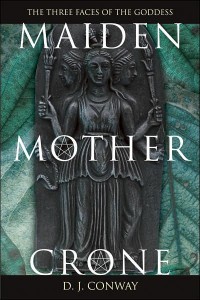 To put things in perspective, Christianity and its worship of a dominant male figure has been in existence less than two thousand years. In contrast, the female trinity of the maiden, the mother, and the crone is stated to have been worshipped for between twenty and thirty thousand years, easily ten times the age of Christianity, and only relatively dominated by a patriarchial belief system. Compared to a person’s lifespan, two thousand years is a frighteningly long time. It’s no wonder that the triple goddess has gone overlooked and underrepresented, remembered by a miniscule portion of humanity.
To put things in perspective, Christianity and its worship of a dominant male figure has been in existence less than two thousand years. In contrast, the female trinity of the maiden, the mother, and the crone is stated to have been worshipped for between twenty and thirty thousand years, easily ten times the age of Christianity, and only relatively dominated by a patriarchial belief system. Compared to a person’s lifespan, two thousand years is a frighteningly long time. It’s no wonder that the triple goddess has gone overlooked and underrepresented, remembered by a miniscule portion of humanity.
D.J. Conway’s book, Maiden, Mother, Crone: The Myth and Reality of the Triple Goddess, explores the myth and reality of the triple goddess, going into history and function, and offering numerous ways to bring the triple goddess figure back into prominence in a person’s belief system. It’s a whole-hearted, enthusiastic look at the female side of things, and a joyful exploration of the feminine aspect of belief. Well-researched and accessible to the common reader, this book is valuable both as a reference source and as a supplement to one’s religious practices.
After an introductory section that goes into light detail about the three faces of the goddess figure and its history, the book proceeds to explore each aspect of the trinity individually, looking at the goddess as maiden, as mother and as crone in turn. An added bonus is that each of these sections includes a chapter listing and retelling some of the appropriate goddess myths collected from all over the world. Religious belief systems represented include the Greeks, Romans, Welsh, Irish, Norse, Chinese and Native Americans, among others. The list is an extensive one, proving that the goddess in any or all of her three aspects can be found in just about any early religion.
A further section goes into detail on “Other Sacred Threes and Multiples,” studying other multiple female figures in religion. Examples include such groups as the Fates, the Muses, the Valkyries and just about any other group of females you can think of. About the only requirement is that they be divine or semi-divine, appear in groups of three or more, and all be female.
Finally, Maiden, Mother, Crone goes on to examine the importance of the triple goddess today, and its potential to restore the balance between male and female in belief systems. An extensive appendix lists numerous meditations and rituals for use in this fashion, offering the curious or serious practitioner a variety of methods with which to invoke the goddess from within and without. Additional endnotes and bibliography exist as a jumping off point if this source leaves you looking for more of any particular myth or tradition.
I approached this book with an open mind and a researcher’s interest, fascinated more by its treatment of mythology and the female figure in myth, and less so by its use as a guide to spirituality and belief. However, after reading Maiden, Mother, Crone, I come away impressed by the care taken to present the material in a way that even the most casual of readers might understand and learn from it.
For anyone interested in exploring the female aspect of spirituality and religion, you can’t go wrong in looking at this book. As a reference volume, it’s functional and well worth the time spent flipping through it, although individual tastes and needs may vary.
